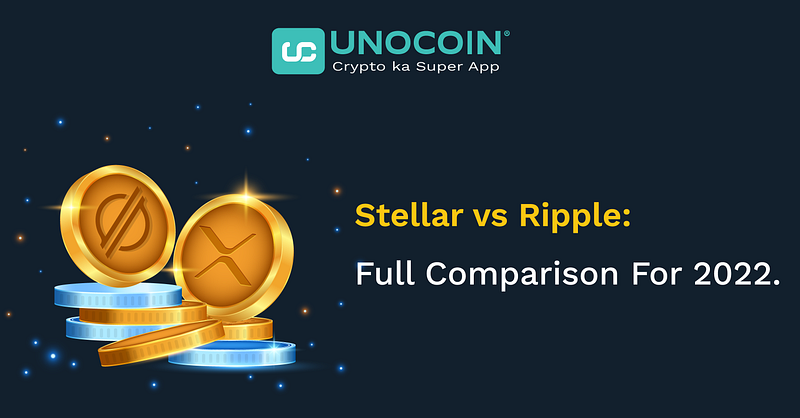This article discusses the outlook for Stellar and Ripple to help you make better investment decisions.
Many people believe that Ripple and Stellar are the same things and that Stellar is a fork of Ripple. Due to the similarities in their blockchains, crypto enthusiasts frequently compare Stellar and Ripple. To understand which of these two cryptos will win in the long run, you need to look at them closely and compare Stellar vs Ripple.

What is Stellar?
Stellar crypto is a digital or virtual Asset that the Stellar Development Foundation created. Stellar later got renamed to Lumen. The Lumen, the organization’s currency, is traded on multiple crypto exchanges under XLM.
Traders on the Stellar network, a blockchain-based distributed ledger network that connects banks, payment systems, and people to support low-cost, cross-asset value transfers, including payments, can use Lumens.
What is Ripple?
Ripple is a financial system that functions as a crypto and a digital payment network. Chris Larsen and Jed McCaleb co-founded it, and it was initially released in 2012. Ripple’s basic policy is to provide a payment settlement asset exchange and remittance system, similar to the SWIFT system for international money and security transfers, utilized by banks and financial mediators.
The crypto’s token, XRP, is pre-mined and has the ticker sign XRP. The company and network are known as Ripple, and the crypto coin is known as XRP.
History of Stellar and Ripple
Years ago, two associates decided to team up to create a blockchain-based system to help financial institutions make cross-border payments. Chris Larsen and Jed McCaleb were their names, and Ripple was the company they formed to provide the answer. Two years later, in 2014, McCaleb left Ripple owing to “differences” in opinion and started Stellar, which offered a similarly rapid and economical cross-border remittance solution but to a different target market than Ripple.
With such a history, it is no wonder that the codes for both solutions were nearly identical — Stellar modified the codes six months after introduction to meet their target market better.
Ripple was intended to address the numerous issues that plague cross-border payments, attempting to alter how massive financial institutions handle remittance payments.
When it comes to cross-border remittances, one of the most common concerns is the high cost, followed by the long processing times. These problems arise due to the inefficient process banks must follow when processing money transfer requests, which involves several different organizations, each of which charges a processing fee and takes a percentage as commission.
Ripple’s patterning technology attempts to alleviate this problem by allowing financial institutions to deal directly with one another without the participation of any third parties. The primary goal of Stellar’s development is to enable fast, and low-cost international money transfers to everyday people, especially those who are part of the world’s unbanked or underbanked population.
Stellar vs Ripple: Key Similarities
Even though Stellar modified a lot of its code to make it different from Ripple’s, they have many similarities, probably more than they would like to admit.
Both Stellar and Ripple use distributed ledger protocols to handle transactions to provide an alternative to legacy systems. Furthermore, both have private nodes and do not enable mining. Both networks have developer control over coin circulation, which means that both Stellar and Ripple can increase the number of tokens in circulation whenever they want.
There are many more similarities in both:
- Private nodes are allowed, but mining is not.
- Both use distributed ledger technology.
- Transactions are practically free and instant, making them perfect for international payments and transfers.
Stellar vs Ripple: Key Differences
Despite their similarities, Stellar vs Ripple have significant differences to justify using both cryptos. The target audiences and purposes of the blockchains are the most significant variations. As previously stated, Ripple was created to appeal to banks, a vast market with a lot of profit potential. On the other hand, Stellar was founded to serve the unbanked by expanding the reach of financial services around the world. Stellar calls itself a “not for profit” organization since its objective is to benefit people rather than make money.
Stellar and Ripple uses different consensus techniques, with Stellar employing a unique consensus mechanism and Ripple employing proof of correctness. Furthermore, Lumen currency is inflationary, whereas XRP is deflationary, implying its circulation increases and decreases. Finally, while both are more decentralized than traditional currencies, Ripple is more centralized than Stellar.
It is also worth noting that Ripple is a considerably larger company that has received a lot more money, most likely due to the difference in target markets. On the other hand, Stellar has a smaller but highly experienced crew and has not placed as much focus on marketing as Ripple.
Stellar vs Ripple in 2022: Which One to Choose?
Many people are confused between Stellar vs Ripple and which one to choose. Both Stellar and Ripple are technologies that have produced some great coins. XRP and XLM have acquired increasing popularity in recent years, with XRP gaining the most capital overall. It is primarily focused on banks, whereas XLM is more focused on individuals.
According to Stellar price prediction and Ripple price prediction, because there is currently litigation involving Ripple, XRP may be impacted, allowing XLM to be ahead of the game in terms of the gains it is capable of getting.
FAQs
- Which is better: Stellar or Ripple?
Because of the lawsuit and exchange concerns weighing on Ripple’s XRP, XLM will be better positioned to attract investment if the crypto industry continues to rise as long as the lawsuit continues.
Unocoin is India’s first and the most secure bitcoin trading app. This exchange app was founded in 2013. You can buy and sell bitcoin instantly using the Instant Buy and Sell feature. Not just this, you can also buy ETH and Sell ETH in no time. With more than eighty-seven coins listed on this best cryptocurrency exchange in India, you can also accept bitcoin from your friends from any location. You can also know which cryptocurrency works best for you with the price ticker and notifications. The most popular cryptocurrencies like Bitcoin (BTC), Ether (ETH), USDT (Tether), BNB, Ripple (XRP), Cardano (ADA), Solana (SOL), Binance USD (BUSD), Dogecoin (DOGE), Polkadot (DOT) and other popular altcoins can be traded on the go. The new Android and iOS applications make Unocoin the best cryptocurrency app. With the unique feature of the Systematic Buying Plan, you can buy and sell bitcoin and Ether periodically. What more? You can start your crypto journey using SBP for as little as INR 10. With another exciting feature called Crypto Basket, you can diversify your crypto portfolio based on market capitalisation (Market Cap) or Volume. These two excellent features make Unocoin the best cryptocurrency platform.
Love Crypto Coins. Love Unocoin.
Please find the list of authentic Unocoin accounts for all your queries below:
- YouTube Channel: https://www.youtube.com/c/Unocoin/videos
- Newsletter: https://medium.com/subscribe/@Unocoin_growth
- Blogs: https://blog.unocoin.com
- Instagram: https://www.instagram.com/unocoin/
- Twitter: https://twitter.com/Unocoin
- Facebook: https://www.facebook.com/unocoin/
- LinkedIn: https://in.linkedin.com/company/unocoin
- Telegram Group: https://t.me/Unocoin_Group
- Telegram Channel: https://t.me/+fasQhTKBsfA5N2Zl
- Telegram: https://t.me/UnocoinSupport_Bot
- E-mail id: [email protected]
- Contact details: 7788978910 (09:30 AM IST — 06:30 PM, Mon — Sat)
- App store link: https://apps.apple.com/us/app/unocoin/id1030422972?ls=1
- Playstore link: https://play.google.com/store/apps/details?id=com.unocoin.unocoinwallet
Disclaimer:
Crypto products are unregulated as of this date in India. They could be highly volatile. At Unocoin, we understand that there is a need to protect consumer interests as this form of trading and investment has risks that consumers may not be aware of. To ensure that consumers who deal in crypto products are not misled, they are advised to DYOR (Do Your Own Research).



